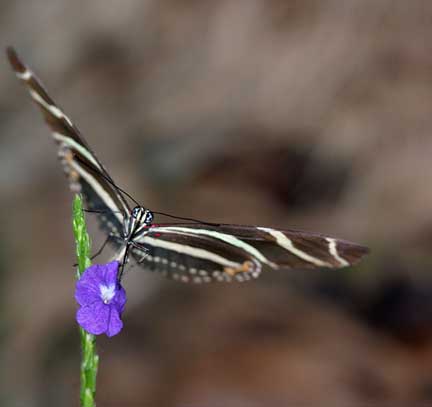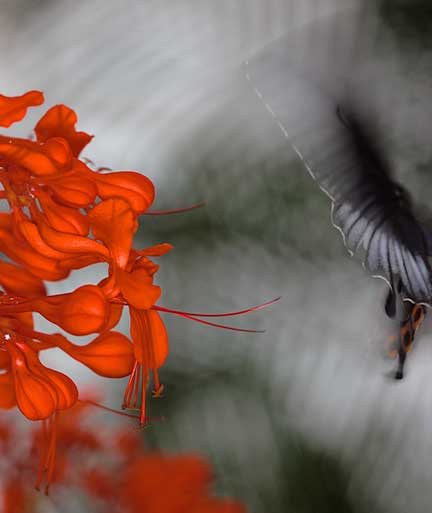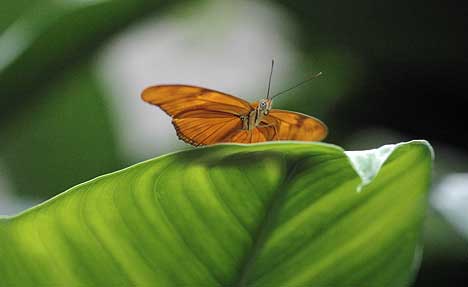 Butterfly 48, Niagara Ontario – April, 2002
Butterfly 48, Niagara Ontario – April, 2002
Canon EOS-D60 and Canon 100mm f/2.8 Macro USM. ISO 800. 1/90 sec @ f/2.8 handheld
Well, almost free. In this case admission to theNiagara Parks Butterfly Conservatorycost $8.50.
Butterflies? Why butterflies? I thought you were a landscape and wildlife photographer?
In truth, up until the last week of April, 2002 I’d never taken a picture of a butterfly in my life. But, on a trip to the Niagara Peninsula of Southern Ontario while testing theCanon EOS D60, the weather was so awful that we escaped the heavy thunderstorms and threatened tornado conditions by retreating into this tropical oasis for an hour or so.
Equipment Used
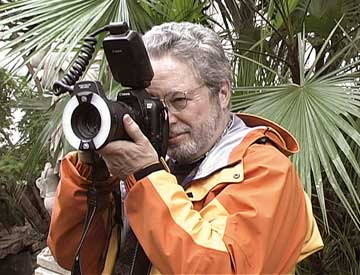
In addition to the D60 camera, for the butterfly photographs shown on this page I used theCanon 100mm f/2.8 Macro USMlens andCanon MR14EXringlight. These are specialized items that unless one does a lot of this type of work will see little use. But if exploring the world of the very small in nature interests you these are ideal tools. A short write-up on macro photography with these items is to be found in my article onCanon Macro Photography.
 2 Butterflies, Niagara Ontario – April, 2002
2 Butterflies, Niagara Ontario – April, 2002
Canon EOS-D60 and Canon 100mm f/2.8 Macro USM with MR14EX Ring Lite. ISO 400
The photograph immediately above was taken with the ringlight, while the one at the top of the page was with available light only. Because it was a heavily overcast day, even though the butterfly conservatory is a greenhouse light levels were quite low. I didn’t want the shots to be solely illuminated by flash as I knew that they would consequently end up looking over-lit and flat. This meant that to achieve a daylight balanced-fill flash effect I needed to use at least ISO 400. On a brighter day ISO 100 might have been feasible.
This worked quite well and for the most part I was able to achieve a natural looking lighting effect.
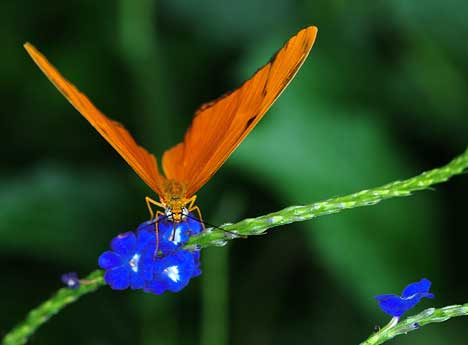 Butterfly 56, Niagara Ontario – April, 2002
Butterfly 56, Niagara Ontario – April, 2002
Canon EOS-D60 and Canon 100mm f/2.8 Macro USM with MR14EX Ring Lite. ISO 400
But not always. The frame titled2 Butterflieslooks very natural. The fact that flash was used is hardly noticeable. On the other hand the frame immediately above,Butterfly 56, is clearly a flash shot.
If you look at the photograph at the top of this page titledButterfly 48, you’ll notice from the caption that no flash was used, but that the ISO speed on the D60 was set to 800. By clicking on the frame you’ll see a larger version, which will allow you to see that the grain is quite visible. On the other hand it is lower than would have been found if an 800 speed film were used, and the ability to change ISO from one shot to the next is most definitely a plus when working digitally.
You’ll notice from the caption ofButterfly 48that it was shot handheld at 1/90th second wide-open. While depth of field is shallow, it certainly is enough to render the butterfly’s head, torso and wings sufficiently sharp.
Condensation
As in any greenhouse or tropical environment when you bring a camera into a warm and humid environment, either from the outdoor cold or a dry air-conditioned room or car, you’ll get condensation on your lenses. If you use a Kleenex from your pocket and try and wipe the front element clear it will fog again it moments. The best thing to do is to simply wait. It will clear by itself, usually in 10-15 minutes as the lens warms up.
Butterfly 56, Niagara Ontario – April, 2002
Canon EOS-D60 and Canon 100mm f/2.8 Macro USM with MR14EX Ring Lite. ISO 400
Fantasy & Interpretation
Few people can fail to appreciate the ephemeral beauty of these tiny frail creatures. But as with most things a literal photographic interpretation often fails to capture thefeelof the subject. Here are two frames, which for different technical reasons manage to capture for me something of theessenceof butterflyness.
Butterfly 68, Niagara Ontario – April, 2002
Canon EOS-D60 and Canon 100mm f/2.8 Macro USM with MR14EX Ring Lite. ISO 400
I had focused on this very large black butterfly as it fed off a brilliant red flower. Just as I was about to release the shutter it started to fly away. By instinct I panned with it as I fired the frame.
Because the camera was set to E-TTL balanced daylight fill-flash the flower petals are brightly lit and sharp. The butterfly (or at least the half that can be seen) is both sharp (from the flash) and blurred (from the ambient exposure of 1/90 sec @ f/5.6). The out-of-focus background of leaves and skylight panes is blurred due to the panning of the camera. All together completely unintentional, yet effective.
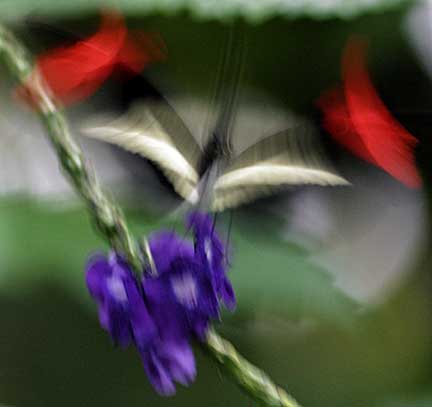 ButterflyBlur, Niagara Ontario – April, 2002
ButterflyBlur, Niagara Ontario – April, 2002
Canon EOS-D60 and Canon 100mm f/2.8 Macro USM. ISO 800. 1/20 sec @ f/2.8 handheld
This final frame is my personal favourite. Unnoticed by me, at one point the flash had accidentally been turned off, and so when I took this frame it naturally failed to fire. Consequently the exposure was just by ambient light, and the aperture priority mode in which I was working set the shutter speed to 1/20th second. But as I reviewed the frame on-screen the next day I saw that a tiny section, representing about 20% of the entire frame, had an ethereal quality and contained a fascinating juxtaposition of shapes and colours. So I cropped it from the larger frame and enlarged it usingGenuine Fractals Pro. Grainy, blurred and out of focus â�� yet it’s my favourite shot of the day.
Canon D60 and Working Digitally
If you’ve come to this page via links from myCanon EOS D60review you are probably wondering how it worked out for this type of shoot. In a word â�� ideally. The camera, lens and flash worked extremely well together and allowed me to produce literally dozens of high-quality frames in a short period of time. The instant feedback of shooting digitally made it possible for me to work efficiently with fill-flash, something that I’m always nervous about when shooting film.
The D60’s poor autofocus was annoying, as always, but since I tend to do macro work in manual focus much of the time this wasn’t a serious impediment.
Certainly the D60’s very high image quality, especially at high ISO ratings, contributed greatly to my ability to crop tightly when printing, yet still retain more than acceptable image quality.
This page is part of my Canon EOS D60 review which also includes
afield-use reportandcomparison with Medium Format.
